40 borax slime lab worksheet
• Take a cup of water add add to it 1 Tbs. of borax (approx. 4% solution). Stir until completely dissolved. • Make a 50% water 50% white glue solution. Take 1/4 cup of each and mix thoroughly. • In a Ziploc bag, add equal parts of the borax solution to equal parts of the glue solution. 1/2 cup of each will make a cup of slime.
method of doing the slime lab allows the students to work as teams and then causes the teams to interact to make comparisons. The students sometimes struggle to find the words to describe the slime in step #6 - encourage them to devise some sort of chart or graphic organizer to record their results/conclusions.
Slime – Polyvinyl Alcohol with Borax Description: This demonstration is typically performed as a hands-on activity for younger audiences but can also be used to discuss polymerization. Two clear colorless liquids are mixed and immediately form a gel with interesting physical
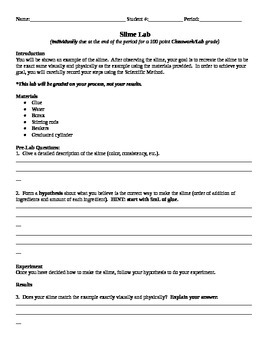
Borax slime lab worksheet
1. Fill one of your plastic cups with about 30 mL of glue. (Until the glue is about 1 inch up the side of the cup) 2. (Optional) Add one drop of food coloring into the glue. Stir well using a popsicle stick to get an even color. 3. Add a few (e.g. 20) drops of the borax solution to the glue and start mixing them together. 4.
The second easy slime recipe is called "Super Slime," and it will teach you how to make slime with borax but without glue. Finally, the Glooze and Oobleck slime recipes reveal how to make slime without borax AND without glue ; instead, they use household ingredients, like skim milk and cornstarch, to transform into amazing, ooey-gooey substances.
Put on your goggles. Be sure to read and follow all the cautions on the borax box label. Keep your slime away from carpets, fabrics, furniture, young children, and pets. Store it in a sealed zip-closing plastic bag when you are not playing with it and wash your hands after playing with your slime.
Borax slime lab worksheet.
1. Make the borax solution. Add 1 teaspoon (4.9 ml) of borax powder into 1 cup (240 ml) of hot water, and stir until the water is fully clear. Set aside for later use. 2. Pour 4 ounces (110 g) of glue into a bowl. 3. Add in 1⁄2 cup (120 ml) of shaving cream. Mix the glue and the shaving cream together.
Procedure. Place 40 cm 3 of the polyvinyl alcohol solution in the plastic cup. If supplied, add one drop of food colour or fluorescein dye to the solution. Stir well. Measure out 10 cm 3 of borax solution into the beaker and add this to the polyvinyl alcohol solution, stirring vigorously until gelling is complete.
Procedure: Mix 1/2 cup of water and 1/2 cup of Elmer's glue with some food coloring. If you use white glue your slime will be pale. If you use clear glue you can get vibrant jewel tones and glitter shows up better. Add the borax solution one teaspoon at a time until the mass begins to adhere and become viscous.
Fantasy potion recipes
Required Cookies & Technologies. Some of the technologies we use are necessary for critical functions like security and site integrity, account authentication, security and privacy preferences, internal site usage and maintenance data, and to make the …
Find slime lab lesson plans and teaching resources. Quickly find that inspire student learning. ... In this polymer instructional activity students complete a lab activity and write down their observations. Get Free Access See Review + Lesson Planet ... students use sodium borax and polyvinyl alcohol to create their solution, then identify ...
In this experiment, a polymer (polyvinyl alcohol) chemically reacts with borax to form a crosslinked polymer network. Individual polymer chains are formed by covalent bonds, which are strong bonds. In making slime, the individual polymer chains are bound together by weak hydrogen bonds.
What is slime and what makes slime so stretchy? Slime science is pretty cool. Find out the science behind slime with our simple and helpful resource.
Sodium borate (Borax) is used as a laundry booster (cleaning agent), in cosmetics, as a fire retardant, and even as an insecticide. It has a molecular formula of Na2B4O7. 3. Hypothesis: If I mix the slime in the correct sequence and in the right proportions, then I feel that the physical/chemical ...
Make Borax Crystal Ornaments Materials Pipe Cleaners - These sparkly tinsel stems would be perfect for the holidays. Festive Cookie Cutters - Keep these around to make squishy Christmas window gels, too! String Pencil Mug, vase, or jar Boiling Water Borax - This is an inexpensive ingredient in so many of our science experiments. Make slime or
This page is a collection of links for children, teachers, and parents. Science topics are based on the curriculum for Kindergarten through grade five, …
by G Atlantaquaria · 2012 — experiment for 5th and 6th Class students. Materials. • 2 small glasses. • PVA glue. • Borax powder. • Spoon. • Food colouring.
How to make it at home · Kids love to play with slime. It’s like a big piece of chewing gum, but you play with it with your hands. It’s like plasticine but it doesn’t stick to your hands, doesn’t leave marks on surfaces and doesn’t keep its form.
Lab: Making Slime through Cross-linking Process (Answer Key) Introduction: Cross-linking is a process that bonds two or more polymer chains together decreasing a material's elasticity and making it more rigid. Charles Goodyear discovered vulcanization in 1839, a process that changed the elastic rubber to improve its strength.
September 9, 2021 - Learn about the types of slime and how to make slime DIY using a few household ingredients. Steve Spangler Science has the best slime recipes that work!
THE CHEMISTRY OF "SLIME" ACTIVITY Background Information: Slime is a fascinating substance that can be fun & educational. It is an example of how chemistry is used in everyday life. Slime is composed of Elmer's glue, water and sodium tetraborate (Borax).
Experiment #14: Polymers I've been Slimed · The Ghostbusters made slime famous with "I've been slimed" line from Bill Murray and the scenes of ectoplasm (slime) used throughout the movie
In this project, you'll be using the natural chemicals inside a potato to light a light bulb. By completing this project, you'll learn about chemical reactions inside batteries and ways to create ...
September 18, 2019 - You can easily make slime with glue and borax for a stretchy, unforgettable science activity.
polymers in glue mixing with the borate ions in the saline solution. What the shaving cream does in this slime recipe is create a different texture than any.17 pages
2. borax solution 6. paper cups 3. food coloring 7. ziplock bag and marker for your best slime 4. wood stirring sticks B. Procedure: 1. Carefully measure 20 milliliters of borax solution into a graduated cylinder. Pour this into one of paper cups. If you want your slime to be colored, add 1-2 drops of food coloring into the borax
BORAX SLIME NOTE: We have recently tinkered with our recipe and found that for a better oozing and more stretchy slime we prefer 1/4 tsp of borax powder (if using clear glue always use 1/4 tsp). If you like a firmer slime and are using white glue, we experimented with 1/2 tsp and 1 tsp. 1 tsp makes a much firmer putty-like slime.
Click to see our best Video content. Take A Sneak Peak At The Movies Coming Out This Week (8/12) Best Romantic Christmas Movies to Watch
this lab, you will need to use some of the methods that are defined in the Set interface. Recall that if set is a Set, then the following methods are defined: -- Returns the number of items in the set. -- Adds the item to the set, if it is not already there. -- Check whether the set contains the item. set.isEmpty() -- Check whether the set is empty. You will also need to be able to traverse a ...
We have compiled all of the worksheets used in this course. You can print them yourself or purchase them bound in book form. These are NOT a full offline course, just the worksheets used in this online course. Level 1 - 4 (1st through 4th) Buy – print Level 5 - 8 (5th through 8th) Buy
THE CHEMISTRY OF “SLIME” ACTIVITY Background Information: Slime is a fascinating substance that can be fun & educational. It is an example of how chemistry is used in everyday life. Slime is composed of Elmer’s glue, water and sodium tetraborate (Borax).
Popular Resources: NGSS - Find new resources to help you implement NGSS in your classroom. Visit my Forensic Science page to find lessons you can use in your current curriculum to target forensics. Explore the Kid Zone to find interactive sites and great resources for your students · Welcome ...
Holiday Approved STEAM Activity | Borax Crystal Growth Experiment | Grade 6 7 8. by. Kimberly Scott Science. 3. $3.50. PDF. Take your borax crystals up a notch in this fun and memorable hands-on lab. Great for teaching journal writing and the scientific method. Teacher guide and alignment to NGSS included.
View Slime Lab Worksheet (1).docx from SCI 155 at Pikes Peak Community College. Samantha Smith Spring 2020 Slime Lab Worksheet Pre-Lab Questions: Answer after reading all of the procedures and before
May 1, 2021 - Borax Slime Lab Worksheet Printable Worksheet Template. ... While making slime together students can fill out this worksheet with their ...
Slime (Polyvinyl Alcohol) Materials: • 4% polyvinyl alcohol (PVA) solution - 50 mL per group • 4% sodium borate solution (borax) • 5 oz. paper cup • wooden craft stick • food coloring • plastic baggy . Safety: • Lab aprons and safety glasses/goggles should be worn. • The borax and the PVA will burn the eyes.
Slime has two components: a borax and water solution and a glue, water, and food coloring solution. Prepare them separately: Mix 1 teaspoon of borax in 1 cup of water. Stir until the borax is dissolved. In a separate container, mix 1/2 cup (4 oz.) white glue with 1/2 cup water. Add food coloring, if desired.
slime. This lab activity utilizes poly (vinyl alcohol), PVA, and a borax solution to process the slime. The sheer size of the PVA molecules (average molecular weight can surpass 100,000 grams per mole) provides students with a real-world example of how large organic molecules can become. Handling the viscous slime, along with seeing the figure
Cross-Linked Polymer Lab. For Teachers 9th - 12th. Students use short-chain polymers and borate ions to produce cross-linked polymers in the lab. For this cross-linked polymer lesson plan, students produce polyvinyl acetate slime and polyvinyl alcohol slime and test their physical... Get Free Access See Review.
• Although this has been written as a demonstration, this activity works quite well as a lab. (If you plan to make a lot of slime, buy your glue by the liter from Flinn Scientific!) • A large mound of slime (3-4 L or more) is especially impressive! It seems to have a mind of its own, and just trying to
July 26, 2021 - Learn how to make magnetic slime at Steve Spangler Science. Our Magnetic Slime Recipe makes a super-cool science fair project. Visit our website to learn more!
ACTIVITY How to make slime! To make a great variety of slime, use the following procedure. The slime forms because of cross-linking between the protein molecules of white glue and the borate ions of borax. 1. Make a saturated borax solution by adding 1 g of borax to 25 mL of water. Stir thoroughly until the borax has completely dis-solved. 2.
Prep Work (15 minutes) Make one batch of slime that you can show your students at the beginning of the lesson. In a mixing bowl, thoroughly mix 1/2 C water, 1/2 C glue, and a few drops of food coloring. Add 1/2 tsp baking soda and mix completely.
Results 1 - 24 of 55 — Grow Your Own Polar Bear uses gummy bears for a fun experiment in the winter or Christmas time! Sweetheart Slime is perfect for Valentine's ...
experiment for 5 th and 6 th Class students. Materials. • 2 small glasses. • PVA glue. • Borax powder. • Spoon. • Food colouring.
Slime Investigation TEACHER WORKSHEET . Level 5-10 . OBJECTIVES. 1. ... depending on slime number, mix together. 4. Add Borax solution to the PVA paste and stir. As you stir the slime should start to form. 5. Remove the “slime” from the beaker and knead for a couple of minutes. 6.
Lab Report. Lab project Phase 3. Undergrad. (yrs 3-4) Psychology. 2. View this sample Annotated bibliography. Project Two Warrantless Search and Seizure Memorandum. Undergrad. (yrs 3-4) Criminal law. 5. View this sample Case study. Interactions of hazardous materials BOS 3640. Undergrad. (yrs 3-4) Environmental studies and Forestry. 2. View this sample Case …
Soap can also help soften slime that is too thick and crumbly from adding too much borax. Make It a Slime Science Activity! If you love slime. grab the slime science lab and learn a little bit about the science behind slime with these slime worksheets! It's a fun way to bring a taste of science to your slime activities!
It also includes a further exploration and STEM challenge. The 4th/5th-grade version can easily be used in older grades. Just increase the expectations of the reasoning. All are available for a bundle discount. Slime Experiment and STEM Activity for Grades K/1. Slime Lab And STEM Experiment For Grades 2nd/3rd.
Make a ball of slime and drop it on the lab bench. Place some slime on the lab bench and hit it with your hand. Write your name on a piece of paper with the marker provided. Apply the slime to your name on the paper, press down, then lift the slime off the paper. Add some slime to your Petri dish.
Science ASSIST has an expert national advisory team with extensive, collective experience across all school laboratory management and safety. It is …
When you mixed the borax and water, you created a suspension of borax. A suspension is a mixture that contains solid particles large enough to make the liquid appear cloudy or murky. By mixing the borax into hot water, instead of room temperature or cold water, the borax can stay suspended much longer.
August 25, 2021 - Wondering how to make slime? Check out Steve Spangler Science for our recipe for slime with Elmer’s Glue and other experiments and science activities for kids.


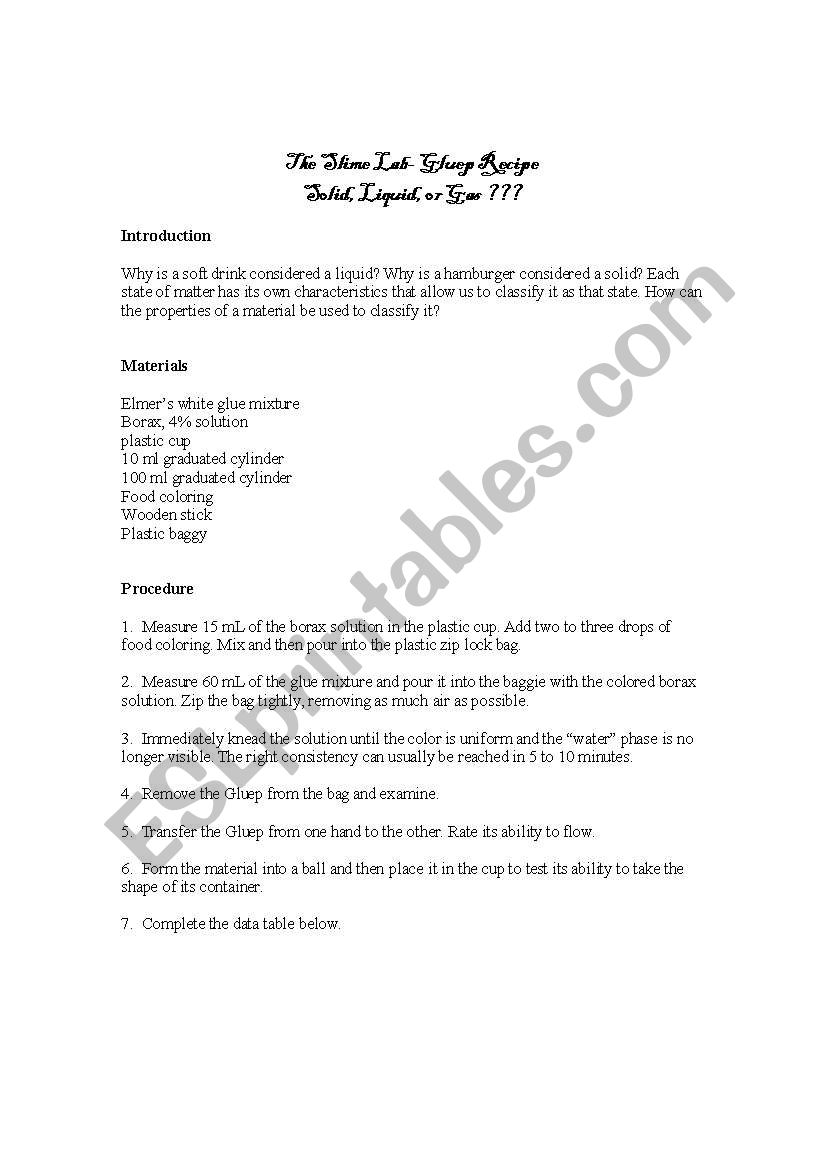


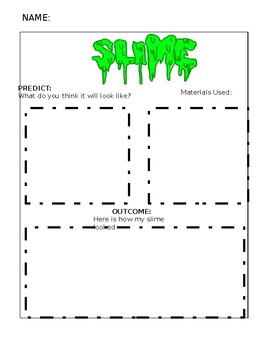
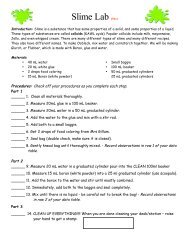

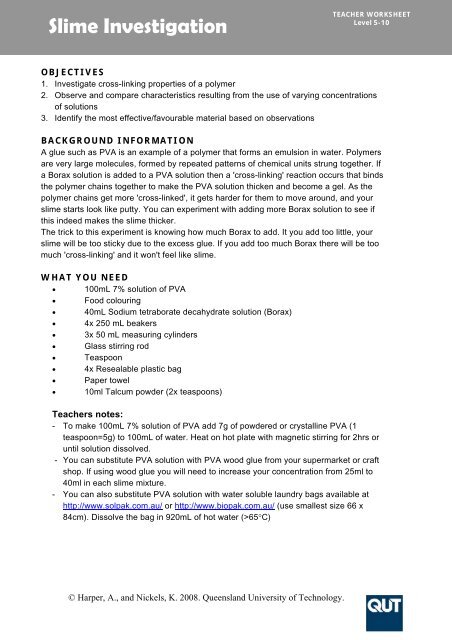






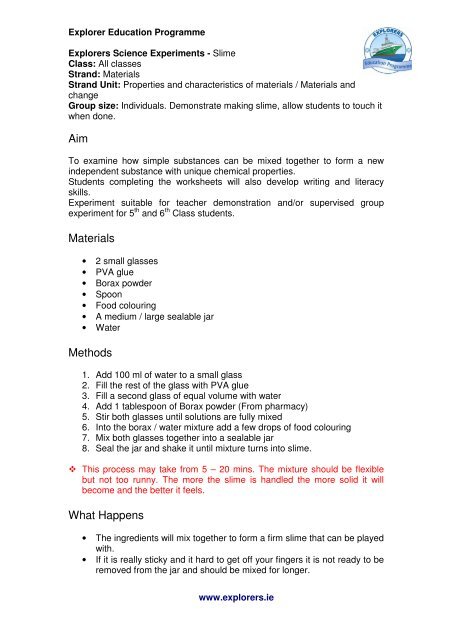



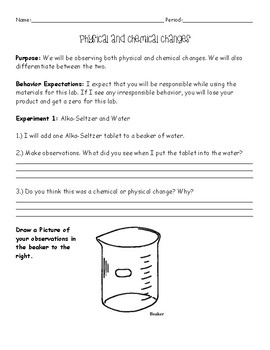





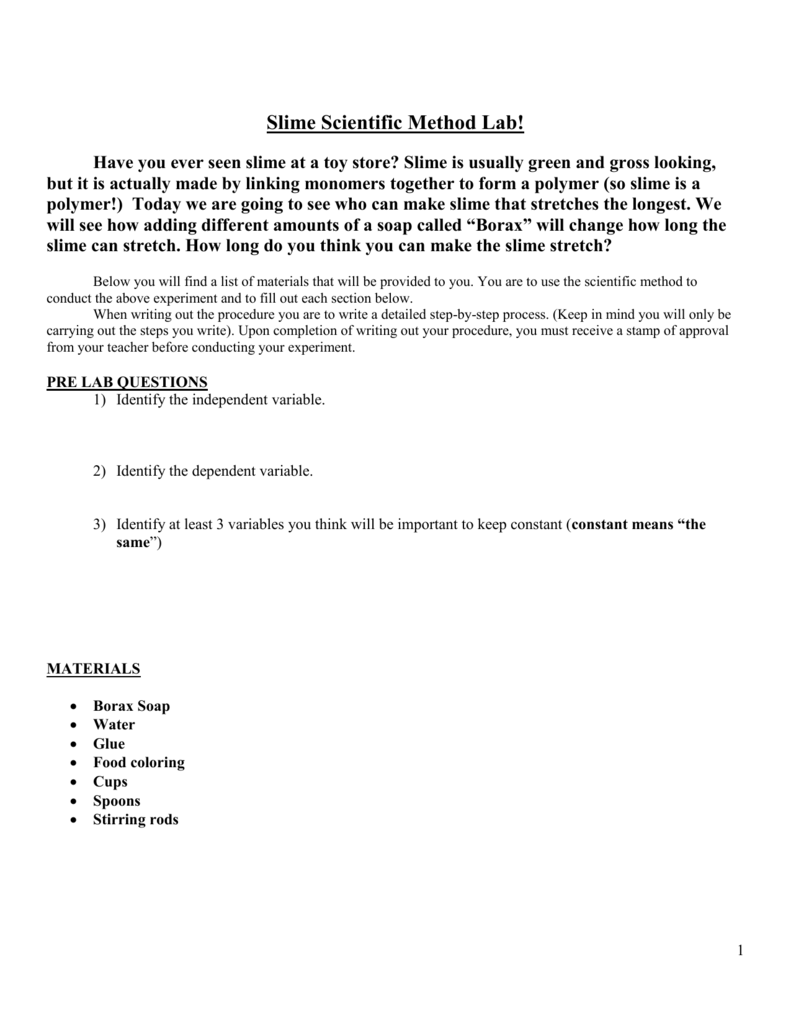
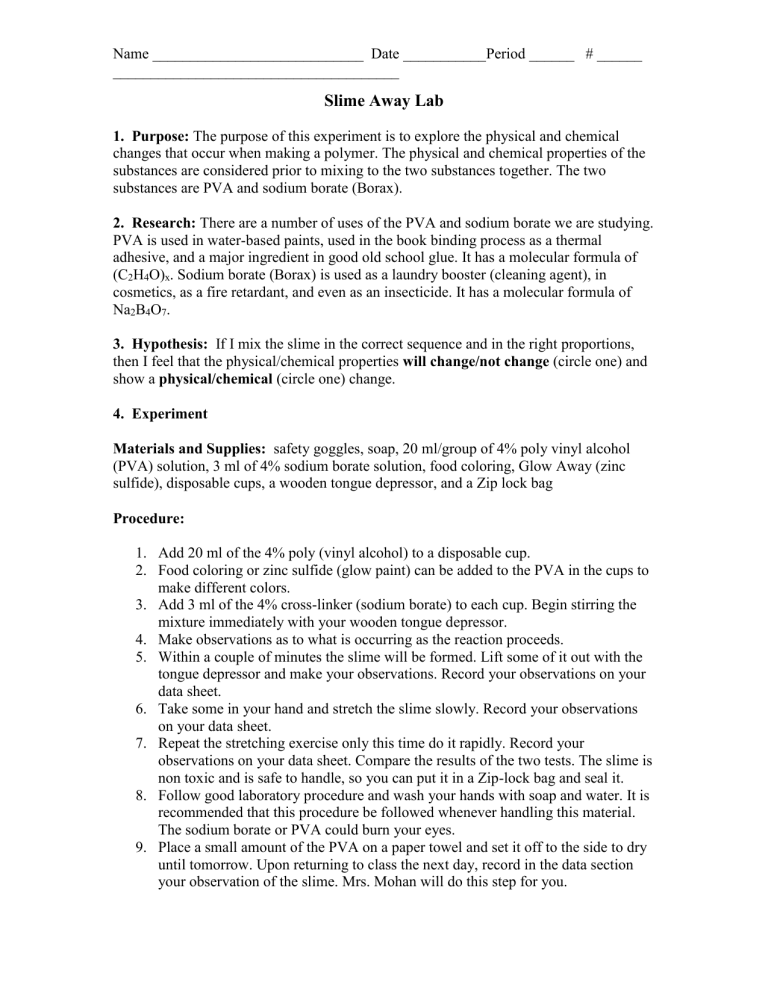



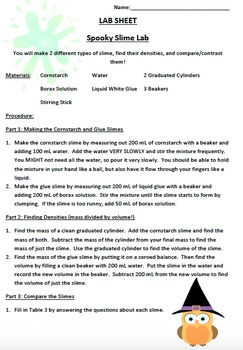


0 Response to "40 borax slime lab worksheet"
Post a Comment